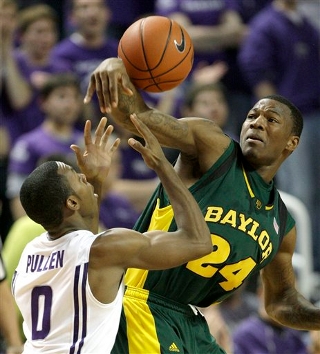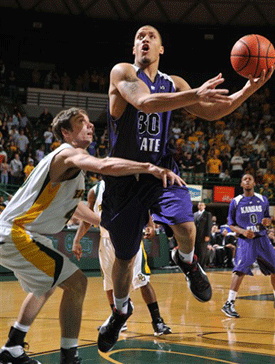Tip: 3 PM CT | TV: ESPN Full Court (affiliate list) The Texas Longhorns return home after a hard-fought road victory against Baylor, sitting just a game out of first place in the Big 12 with a 4-1 mark. Their waiting opponents are the Kansas State Wildcats, a team that is much better than their 2-4 conference record would indicate. But lest my dear readers think I am playing Chicken Little with a KSU team that lost to Texas by nine at home last season even with Michael Beasley and Bill Walker — two players who will not be on their roster today — a quick glance at Kansas State’s strengths should support my claims. Their strengths The Wildcats rebound the ball well, particularly on the offensive glass. And for a Texas team that doesn’t score a ton of points and relies upon its defense to win games, there is nothing more frightening than the thought of numerous solid defensive stands being wiped away as KSU swipes an offensive board and adds a possession. The Wildcats are grabbing 42.8% of their offensive rebounding opportunities, which is good for second-best in the nation. The Longhorns, meanwhile, are already slightly below-average in allowing their opponents to grab those offensive rebounds, giving them up on 32.3% of the opportunities. If Texas cannot keep KSU off the offensive glass, this game will be much closer than it should be, and the Wildcats could even pull off their second straight win at the Frank Erwin Center. Kansas State also shoots the ball well from outside, a fact that has kept them competitive in games against much better teams such as Oklahoma. The Wildcats are hitting 36% of their shots from long range, led by sixth man Fred Brown, who has knocked down 43% of his attempts on the year. Texas has improved their three-point defense as the year has progressed, but it should be noted that in the Longhorns’ four losses this season, opponents have hit 38% of their attempts from long range.
Pullen and the Wildcats can’t hang on to the ball The glaring weakness The one obvious problem that Kansas State has, though, is an inability to handle the basketball. Against Kansas, they turned it over eight times in the first seven minutes and fell behind 18-0 before you could say “Jim Wooldridge in a neck brace.” After hanging with Oklahoma for a half in the conference opener, KSU turned the ball over on seven straight possessions to give the game away. And in a 22-point road loss to Nebraska two weeks ago, the Wildcats coughed it up twenty-five times. Twenty-freakin-five. Jacob Pullen is the biggest offender on the team, with 62 turnovers logged so far while only dishing out 68 assists. For a team with a lack of a true post player inside, this type of carelessness by the guards is highly problematic. Even point guard Denis Clemente has an awful assist-to-turnover ratio at 1.4-to-1. As often as the Wildcats extend possessions with their great offensive rebounding, they shoot themselves in the foot by giving those same possessions away with poor ball handling. Keys to the game As should be clear based on the above paragraphs, Texas has to crash the glass and harass the ball handlers for Kansas State. But they also cannot afford to let KSU push the tempo. The Wildcats run much deeper than Texas, as six players average twenty minutes of playing time, while two others see at least ten minutes a game. Kansas State definitely has the horses to push the transition game, as Denis Clemente is an incredibly fast guard who looks like a water-bug when he scurries coast-to-coast for a layup. Texas is a more talented team, but if KSU can tire the Longhorns out and force Rick Barnes to look further down the bench for fresh bodies, it plays into the hands of Wildcat coach Frank Martin. In addition, Texas must exploit their strengths inside. While Luis Colon and Jamar Samuels block a lot of shots, they also put their opponents on the free throw line quite often. Kansas State opponents shoot an average of 24 free throws per game, which is nearly one free throw attempt for every two field goal attempts. According to Ken Pomeroy’s rankings, that puts KSU at 333rd in the country out of only 344 Division I teams. Texas must pound it inside, get to the line, and force Martin to use his depth in a reactive fashion as his players pick up fouls. |










